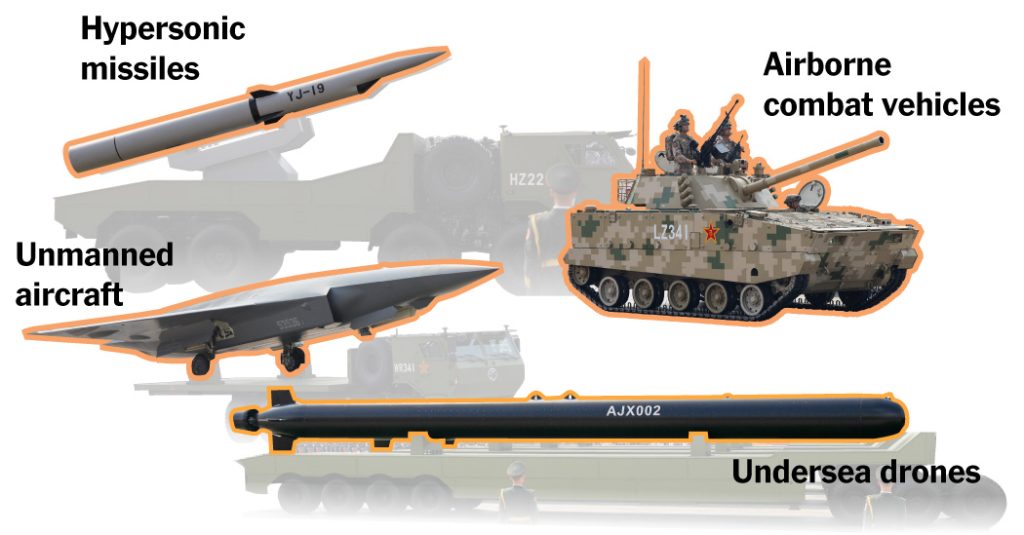China Flexes Military Might with Advanced Weapons Display at National Parade
Beijing Showcases Arsenal of Next-Generation Technology Aimed at Projecting Power
In a dramatic demonstration of China’s growing military capabilities, Wednesday’s parade through Beijing’s Tiananmen Square unveiled an impressive array of cutting-edge weaponry designed to challenge U.S. military dominance in the Asia-Pacific region and beyond. The carefully choreographed event, presided over by President Xi Jinping, featured hypersonic missiles, autonomous vehicles, unmanned aerial systems, and nuclear-capable ballistic missiles—all sending a clear message to potential adversaries about China’s expanding military prowess.
The parade, marking the 75th anniversary of the People’s Republic of China, served as a rare window into Beijing’s military modernization program, which has accelerated significantly in recent years. Military analysts noted that the display revealed China’s strategic emphasis on unmanned systems and hypersonic technology—areas where Beijing hopes to gain tactical advantages in potential future conflicts, particularly in the Taiwan Strait and South China Sea.
“Beijing’s decision to showcase these weapons sends a not-so-subtle message to Taiwan and Washington that China has the ability to threaten American warships,” said Timothy R. Heath, a senior researcher at the global policy institute RAND who studies the Chinese military. The parade’s timing coincides with heightened tensions in the region and growing concerns about China’s territorial ambitions.
Anti-Ship Missiles Target U.S. Naval Vulnerability
Among the most significant revelations were four new models of anti-ship missiles, three of which Chinese state media claimed were hypersonic—capable of traveling at least five times the speed of sound while maneuvering to evade defensive systems. These weapons appear specifically designed to counter U.S. naval power in the Western Pacific, potentially altering the strategic balance in the region.
The YJ-19 cruise missile garnered particular attention from defense experts. This advanced weapon reportedly employs “scramjet” technology, which burns fuel in an airflow moving at supersonic speed to achieve extraordinary velocity. Eric Heginbotham, a principal research scientist at MIT’s security studies program, noted that the missile’s features suggest “both a highly unpredictable flight path and the ability to fly its last leg at a lower altitude than ballistic missiles, albeit at a slower speed.”
By deploying multiple hypersonic missiles with varying speeds and attack angles, China aims to overwhelm ship defense systems, making it exponentially more difficult for naval vessels to counter simultaneous threats. However, experts caution that the operational status of these missiles remains unclear. “Not all of what they will show will be operational,” Heginbotham said. “That’s been true in the past, and it remains true now.” The actual impact on U.S. naval vulnerability will depend largely on China’s production and deployment capacity.
Ground Forces Modernization Signals Extended Reach
The parade showcased several innovations for China’s ground forces, including new armored vehicles equipped with periscope-like viewers that can be deployed from transport aircraft. These vehicles represent a significant upgrade in China’s ability to project power rapidly beyond its borders.
Joshua Arostegui, research director at the China Landpower Studies Center at the U.S. Army War College, observed that these developments indicate China’s investment in rapid deployment capabilities potentially targeting Taiwan or even territories far beyond China’s immediate sphere. “Adding such advanced armor to the airborne corps will give these light infantry forces much more firepower and protection when they are dropped behind enemy lines or rapidly responding to dangerous situations abroad,” he explained.
Also featured were remote-controlled armored buggies designed for mine clearance and casualty evacuation, further demonstrating China’s push toward battlefield automation. These unmanned ground vehicles could reduce risks to personnel in hazardous environments, though Arostegui noted that “the biggest issue with these systems is going to be cost and repair,” highlighting potential limitations in their practical deployment.
Underwater and Aerial Drones Signal Technological Leap
In perhaps the clearest indication of China’s strategic direction, the parade introduced several advanced unmanned systems designed for sea and air operations. Two sleek submersible drones made their debut, signaling China’s determination to compete with the United States in undersea warfare using “extra-large uncrewed undersea vehicles.”
One of these vessels featured a 60-foot, torpedo-shaped hull with a smooth exterior, while another displayed small masts potentially used for communications. Jennifer Parker, a former anti-submarine warfare officer in the Australian Navy and current expert at the National Security College of Australian National University, noted that while specific capabilities remain classified, “the range of types indicates they may be more advanced in this endeavor than other countries.”
Parker suggested that some models may be weaponized, pointing specifically to the AJX002 model: “Given the lack of masts and its size, it looks like it’s weaponized. Could be some sort of self-propelled mine or torpedo-like capability.” This development could significantly alter the underwater battlespace, traditionally dominated by manned submarines.
The aerial component featured large drones resembling fighter jets, demonstrating China’s investment in “loyal wingman” technology—unmanned aircraft designed to fly alongside piloted fighters. These systems, leveraging artificial intelligence, could provide surveillance, attack enemy aircraft, and shield manned fighters from incoming missiles. Andreas Rupprecht, a Germany-based expert on Chinese military aviation, noted that “in many technological areas, it is in the fast lane—sometimes on par with, or even ahead of, leading powers.” However, none of these unmanned aircraft were shown in flight, suggesting they may still be under development.
Nuclear Arsenal Expansion Raises Strategic Concerns
Among the most strategically significant weapons on display were China’s nuclear delivery systems, particularly the missiles labeled “DF-31BJ” that rolled through Tiananmen Square. These intercontinental ballistic missiles are capable of striking the continental United States and hint at China’s ongoing nuclear expansion program.
Ankit Panda, a senior fellow at the Carnegie Endowment for International Peace and author of “The New Nuclear Age,” indicated that the designation suggests these may be variants of China’s road-mobile DF-31 intercontinental nuclear missile, adapted for silo launch. This assessment aligns with recent satellite imagery revealing three new missile silo fields under construction in China’s northern deserts.
While China maintains secrecy regarding its nuclear arsenal, the Federation of American Scientists estimates Beijing possesses approximately 600 warheads—a number that appears to be growing. The construction of roughly 320 new missile silos represents a significant expansion of China’s nuclear capabilities, though reports suggest only about 10 silos in each field may currently contain operational missiles.
“For now, parading the DF-31BJ is likely the closest we’ll come to China acknowledging new silos,” Panda noted, highlighting Beijing’s typical reticence regarding its strategic nuclear forces. The display comes amid concerns about China’s departure from its historically minimalist nuclear posture toward a more robust deterrent capability, potentially altering global strategic stability.
Strategic Implications for Regional and Global Security
The comprehensive display of China’s military technology carries profound implications for security dynamics in the Indo-Pacific region and beyond. By showcasing these advanced weapons systems, Beijing aims not only to deter potential adversaries but also to signal its emergence as a leading military power capable of challenging U.S. dominance.
For neighboring countries, particularly Taiwan, the parade serves as a stark reminder of China’s growing ability to project force. The focus on rapid deployment capabilities, long-range precision strike weapons, and unmanned systems suggests preparation for potential conflicts in the Taiwan Strait and disputed territories in the South China Sea.
As tensions continue to simmer in these flashpoints, China’s military modernization presents significant challenges for regional stability and the existing security architecture. The technologies displayed on Wednesday demonstrate that China has moved beyond merely copying foreign designs to developing innovative systems tailored to its specific strategic needs—a development that will likely accelerate competition in sensitive military technologies with the United States and its allies in the coming years.











